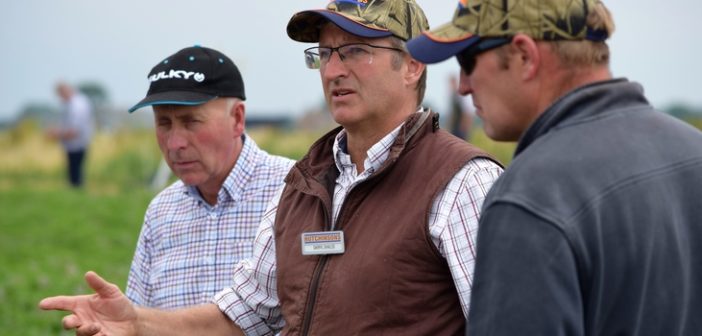New trials by leading agronomy firm Hutchinsons could pave the way for significant improvements to future potato agronomy.
The Fenland Potato Demonstration at Friesland Farm near Mildenhall, Suffolk is examining several key areas, including nitrogen rates, crop safety of post-emergence herbicides, the impact of seed age on yield and integrated PCN management.
Despite only being mid-way through the first season, growers attending a recent open day at the site witnessed some interesting early findings which could help inform future decision-making.
The nitrogen trial in particular reveals notable differences, especially when comparing it to the surrounding commercial crop of Maris Piper, Hutchinsons fertiliser manager Tim Kerr says.
The trial itself clearly shows variations in tuber size, advancement and haulm growth at the different nitrogen rates of 0, 100, 200 and 300kg/ha, but he says the most significant difference this spring is more down to how the nitrogen has been applied.
He believes the surrounding commercial crop has performed better than the trial area because the base NPK fertiliser was placed in a band close to seed either side of the ridge, whereas in the trial it was broadcast onto the ploughed surface and incorporated during ridge formation.
“The availability of less mobile nutrients, especially phosphate, can be compromised in dry weather meaning they are less readily available for developing crops to take up. Placing fertiliser close to where it’s needed allows more efficient use of it, especially in dry soils.”
Mr Kerr also emphasises the importance of phosphate and potash in early root development. “Crops with ample N, P and K available will produce stronger roots that are more capable of extracting water and nutrients when needed and help overcome any other limiting factors through the season.”
Shedding light on crop safety
Perhaps the most visible differences are in the herbicide trial, where the crop effects of four post-emergence herbicides are under investigation across a range of 22 new and established varieties.
“There’s very little crop safety information available from manufacturers, who do not screen many new varieties, so we want to shed more light on how different varieties are affected by post-em treatments,” Hutchinsons root crop technical manager Darryl Shailes says.
All varieties were planted on 30 May with herbicides applied in late June when crops had reached 15cm high. Treatments included two rates of metribuzin (0.5kg/ha and 0.2kg/ha), Basagran SG (1.65kg/ha) + Phase II (2.0 litres/ha) and Titus (50g/ha).
“Initially there was quite a lot of impact from the treatments, but because the soil here is so forgiving and crops received decent rainfall at the end of June, many subsequently grew away from those initial effects.”
There are still notable differences in the impact of treatments on individual varieties, with some crops – even those where post-em herbicides are not recommended – showing virtually no ill effects, while others have suffered more significant yellowing, scorch or other damage to haulm growth.
Mr Shailes cautions against drawing any conclusions from one year’s trial and insists further work is needed before advice can be given about the crop safety of post-em treatments on specific varieties.
Work in progress
There are less discernible differences in the seed age and PCN trials, but experts believe further tests after harvest could reveal interesting results.
In the seed source and age trial, seven different Maris Piper seed lots of varying age are being compared at two planting spacings; one based on AHDB seed rate charts and the other at standard 15” spacing. Chits and stem number have been recorded and yield and size grade will be measured at harvest.
“Last year saw low tuber numbers in the 6s and 7s rather than 10s and 12s. This may have been down to dull weather at tuber initiation, but we want to examine it further and see if there are any differences between the age or source location of seed,” says agronomist Stefan Williams.
Meanwhile John Keer and his Richard Austin Agriculture colleague Michael Roger are investigating the impact of different nematicides and varietal resistance and tolerance on potato cyst nematodes.
Replicated plot trials have been set up in an area of field suffering high incidence of Globodera pallida. One part of the site is comparing five nematicide treatments on Maris Peer, while another set of trials is examining how 15 varieties with varying resistance and tolerance fare with and without a nematicide.
Initial egg counts show a PCN population of 36-53 eggs/ g soil and this will be compared to a final count and measure of yield/ grade after harvest.
“There is a crucial difference between resistance and tolerance that growers have to remember,” says Dr Keer. “Resistance prevents PCN completing its lifecycle, so will allow you to gradually reduce PCN levels in the soil, but it tells you nothing about the crop’s ability [tolerance]to withstand a PCN attack. There isn’t much information from breeders on varietal tolerance to PCN.
“The ideal is to have a variety with dual resistance to both types of PCN – rostochiensis and pallida – and good tolerance. New varieties are getting very close to this.”
He reports little visible difference in crop growth within the trial so far, but says the most interesting results will come from the final PCN count later in the year.
A follow-up meeting to discuss all findings from Friesland Farm trials is due to be held this winter. Look out for more information at www.hlhltd.co.uk or contact our Wisbech office, 01945 461177.
About Friesland Farm
- Owned and managed by A. L Lee Farming Company
- Farmed area totals 4,850ha (12,000 acres) across Cambridgeshire, Suffolk and Norfolk
- All irrigable
- Diverse rotation with potatoes grown 1 year in every 6-8
- Focus on processing and chipping varieties
- Trials site is on sandy black Fen soil (high organic matter and fertility)
- Strong focus on maximising soil fertility and sustainability across the farm.




